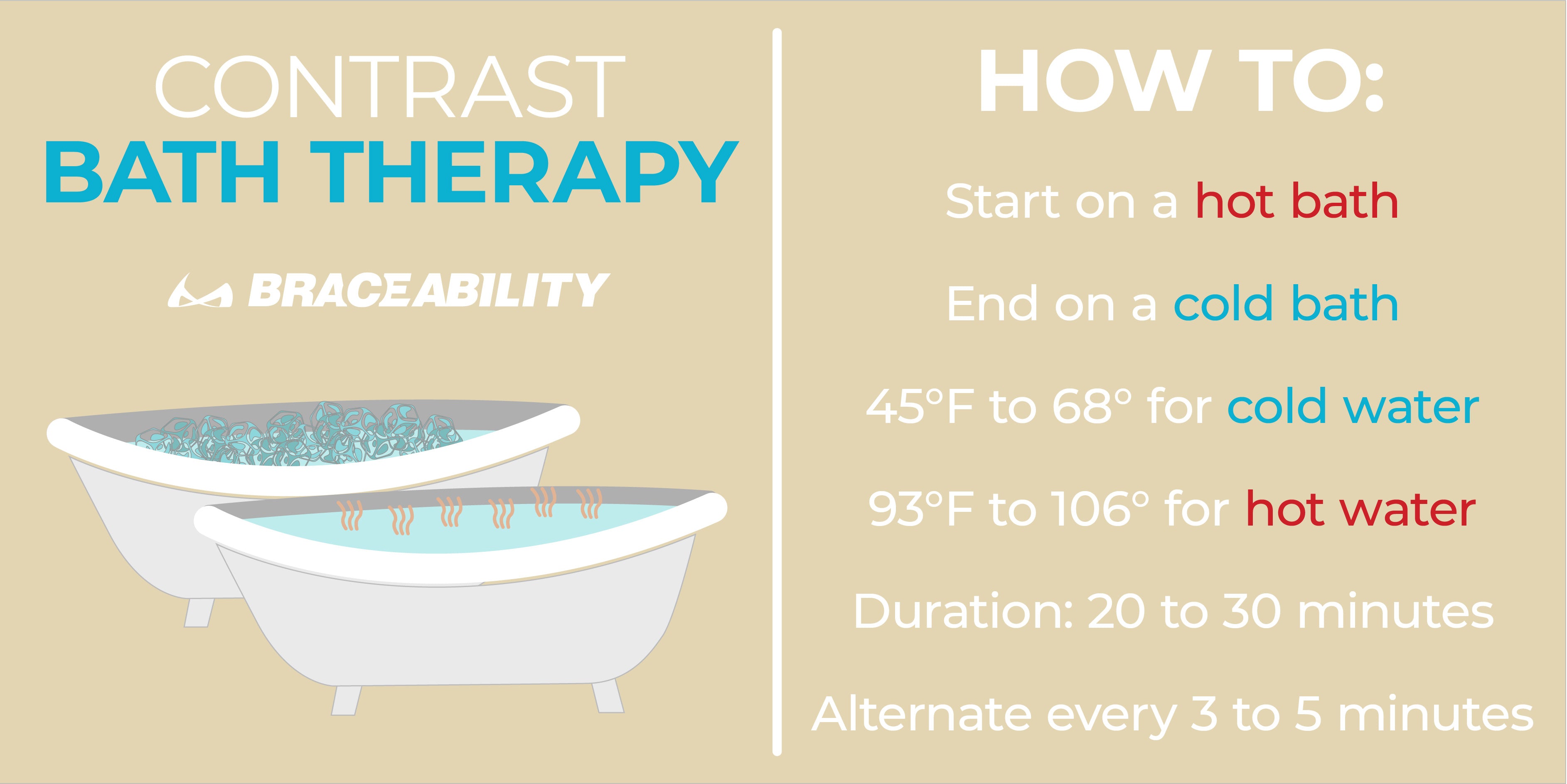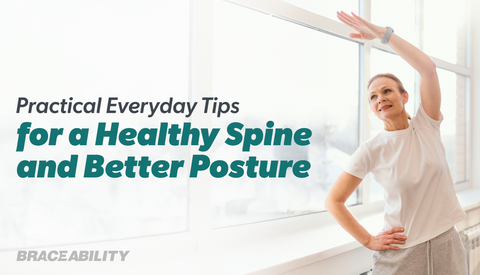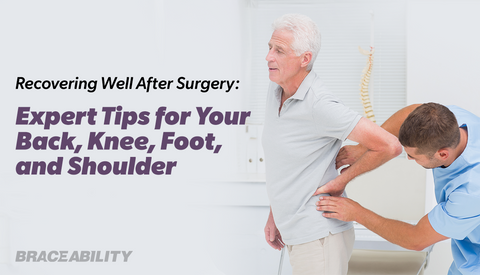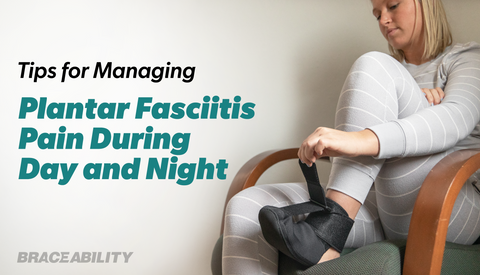Don’t Let Back Pain Hold You Back. Find Out What to Use (Heat vs. Ice) to Loosen Stiff Muscles at Home
There are many reasons hot and cold therapy are go-to methods to treat just about any form of soreness or injury to your body. They are easy, safe, inexpensive and environmentally-friendly ways of relieving pain that can be done from the comfort of your home. They also come without any of the side effects or risks that come with many other treatment options.
That said, cold and heat therapy also are not as potent as many other methods. And it can be tough to determine whether you should use heat or ice for back pain.
But don’t fret—this post walks you through that decision-making process, helping you to determine what is good for your back pain (and other aches or injuries)—ice or heat.

Heat Therapy: Why a Heated Back Brace Is a Good Way to Get Rid of Back Pain
Generally speaking, heat therapy (AKA, thermotherapy) is your best solution for sore, stiff or aching muscles, especially in the neck or back.
Your muscles typically respond well to heat, especially when your discomfort stems from overexertion, trigger points (knots), spasms, cramps (including those related to your menstrual cycle), bad posture, or restless leg syndrome.
Using a heating pad is also one of the best things you can do for easing pain or stiffness stemming from arthritis.
A heating pad can also soothe “hurts-all-over” pain or sensitivity stemming from fibromyalgia, sleep deprivation, rheumatic diseases or vitamin D deficiency, to name a few examples.
How Does Heat Therapy Work?
In general terms, using a heated back brace or soaking in a warm tub brings a lot of therapeutic benefits. For most people, heat is comforting, relaxing and reassuring.
Chronic pain goes hand-in-hand with sensitization, anxiety, tension, and hypervigilance. Applying comfortable heat to your stiff back muscles or relaxing in a sauna can soothe an over-stressed nervous system.
More scientifically speaking, heat can help your blood vessels to dilate, allowing blood to flow more freely. This helps with the removal of toxins and encourages healing.
How to Loosen Tight Lower Back Muscles Using Heat Therapy
- In most cases, applying heat to the painful area for up to 20 minutes an hour will help.
- For more severe injuries, you may need to apply the heating pad to the low-, mid- or upper back for 30 minutes to two hours. In such cases, you should probably buy a reusable heating pad for back pain that wraps around the body.
- Always place multiple layers of towels between your skin and the heat source to prevent burns.
- Your heat belt should be at a warm temperature, not a hot one that could decrease comfort/burn skin.
- You can use a heating pad to help with low-back pain during pregnancy, so long as you do not apply heat directly to the belly.
Should You Use Dry Heat or Moist Heat for Muscle Pain in Your Back?
The answer to this question really comes down to your preference and what’s most convenient. Dry heat (think electric heating pads or saunas) tend to draw moisture out of the skin, leaving it dehydrated. But some prefer the sensation of dry heat and it is often the easier version to apply.
Moist heat, such as a hot bath, steamed towel or moist heating packs, can help heat to penetrate into muscles, bringing better results for some. But this can also be less convenient to apply and some do not like the mix of moisture and heat.
You may need to experiment to see what works best for relieving your back pain.
When Heat Therapy Is NOT the Answer
There are times when applying heat will make your discomfort worse or when ice therapy is a better option (though this is rarely the case for back pain).
If you have truly pulled or strained your lower back muscles, applying heat will cause inflammation. Heating inflamed tissues will make your pain worse and certainly won’t help things get better any time soon.
Another scenario when heat therapy is not a good idea is if you are already sweating. Adding even more heat can come across as a threat signal to your brain, prompting it to up your pain response.
This seems kind of obvious, but you should not apply heat to an open wound or infected tissue. Heat therapy should also be avoided when treating:
- diabetes
- dermatitis
- deep vein thrombosis
- peripheral vascular disease
Ice Therapy: A Few Scenarios When It’s Good for Back Pain (e.g., Lower Back Strain)
Ice therapy, also known as cryotherapy, is generally meant for fresh injuries. The cold of an ice pack calms inflamed, hot, red or swollen tissue.
While this is your body’s natural (and healthy) reaction to an injury and a component of the healing process, it can be quite painful and last longer than it needs to.
Applying a cold gel pack to your freshly injured back or some other area of the body can dull pain and bring down swelling.
How Does an Ice Pack Help?
So what happens when you apply an ice pack to the back or knee? The cold temperatures restrict blood flow to your muscles, which helps to reduce bruising, swelling and pain.
Once you remove the ice pack, your muscles will warm and blood vessels expand, ushering in a flood of new blood, helping to clear debris left by injury and accelerating the healing process.
Cold therapy is a great option for fresh injuries like a pulled, sprained or strained back muscle or a new case of IT band syndrome.
When Ice Therapy Is NOT the Answer
As with heat therapy, there are times when it can be tempting to slap a bag of ice on any sore or twitching muscle. But doing ice therapy for back spasm and a number of other problems can actually do more harm than good.
You should not ice for:
- General muscle pains
- Trigger points (sensitive, painful spots in your muscles, also known as muscle “knots”)
- Reducing body fat (yes, that’s a thing)
Also, this is pretty intuitive, but you should not apply ice if you’re already shivering.
Another word to the wise—you may think you have “pulled” or “strained” a muscle in the back or neck, but actual tissue damage is quite rare. The tissue of the back is really thick and it takes a lot of force—like whiplash from a car accident or lifting something very heavy—to actually tear muscles.
So when it comes to answering the question—what’s good for back pain, heat or cold?—heat usually wins out.
And if you indeed have a back strain from lifting or something else, you should only apply ice for a few days and then switch to heating pads.
Where to Buy a Heat/Cold Compress as Big as Your Back
Dreading the thought of seeking out ice and heat packs for injury care? This large hot and cold back wrap that comes with two gel packs simplifies injury treatment.
It is specifically designed to provide concentrated cold/hot therapy to your sore or injured back, with the added benefit of compressing and supporting your mid- to low-back.
You can put the low-profile wrap on under or on top of your clothes. The belt-like product makes it easy for you to ice or heat your back on the go, and its lightweight foam material is soft and breathable.
Without it, you may be stuck lying on your stomach for long periods each day with an ice pack or heating pad. Sticking to a regular ice/heat therapy schedule (which is far easier to do with this belt) leads to faster and more lasting results.
This hot/cold therapy belt has pockets for two non-toxic gel pads, which come with your purchase. You can also buy extra gel packs so you don’t have to wait as long for an ice pack to refreeze. Both reusable ice packs are freezer and microwave safe.
Best Practices: How to Ice Your Back
- Apply ice to the sore area for 10 minutes every hour.
- Stick to the every-hour schedule. The more often the cycle/transition happens, the faster your body can heal.
- Place a thin barrier like a towel between the skin and ice pack to prevent skin damage.
- If you’re using ice therapy for therapeutic or athletic reasons, you should do so several hours after your workout. Ideally, this should be done the first thing in the morning/and or right before bed.
Trends in Cold Therapy
Ice has long been a central component of post-workout recovery for athletes, as an ice bath can soothe inflamed, post-workout muscles.
That said, cold therapy should not occur right after workouts. While an ice bath might feel great, this post-workout inflammation is actually an important element of helping an athlete to become stronger and more resilient.
Some athletes use controlled cold exposure (e.g., a three-minute cold shower or an ice bath at the end of the day) to reap hormonal benefits and gain a mental edge. Some studies have also shown that therapeutic cold exposure can lower your risk of upper respiratory infections.
Contrast Therapy: Using Both Cold and Heat Therapy for Back Pain
Hot/cold immersion therapy alternates quickly between cold and heat therapy to jolt your body’s circulation. As you might imagine, rapidly shifting between hot and cold water can be very stimulating, but outside of that, the benefits of this method of dealing with an injured latissimus dorsi (back muscle) or any other injury is fairly unknown.
Some studies have shown contrast therapy can improve your body’s immune system, but others show minimal net benefit or near equal benefits as with doing cold and heat therapy separately.
Contrast therapy can be used for recovery purposes after a trying workout or to reduce swelling related to injuries. But it should not be used for fresh injuries when swelling, heat and redness are still present.
How to Do Contrast Therapy
- Most use cold water temperatures between 45°F and 68°F and hot water temps between 93°F and 106°F.
- Cycle between cold and heat over a 20 to 30-minute period, with each immersion into cold/hot water lasting three to five minutes.
- Most believe it’s best to end on the cold bath.

7 Other Steps for Stiff Back Treatment
- Use good posture throughout the day.
- Try doing some shoulder shrugs or stretches to ease tension.
- Get or give yourself a massage (and make sure to drink plenty of water afterward to flush out toxins).
- Add a pad to your office chair to make it more comfortable.
- Wear an industrial back support brace when you lift heavy items.
- Take microbreaks at work.
- Use pillows to straighten your back while sleeping.
- Rub some cream meant to relieve pain or try a pain relief patch on any tissues that ache.
Bottom Line on What to Use for Back Pain—Ice or Heat
So as we’ve explained, heat is usually your best option for treating back pain or a sore neck, though exceptions do apply. But there are also some other options you might try in addition to using heating pads for back pain relief.
In the end, what you should use for relieving muscle pain in the back will come down to user preference. How you feel about ice or heat therapy will impact its effectiveness, as your body will respond either by relaxing or with alarm.
So while you should use the guidance of this article to make an informed choice, you should also listen to your body. If the idea of using a heating pad on your neck or low back makes you sweat, ice may be your better option—science aside.
The bottom line: Go with what feels good.










